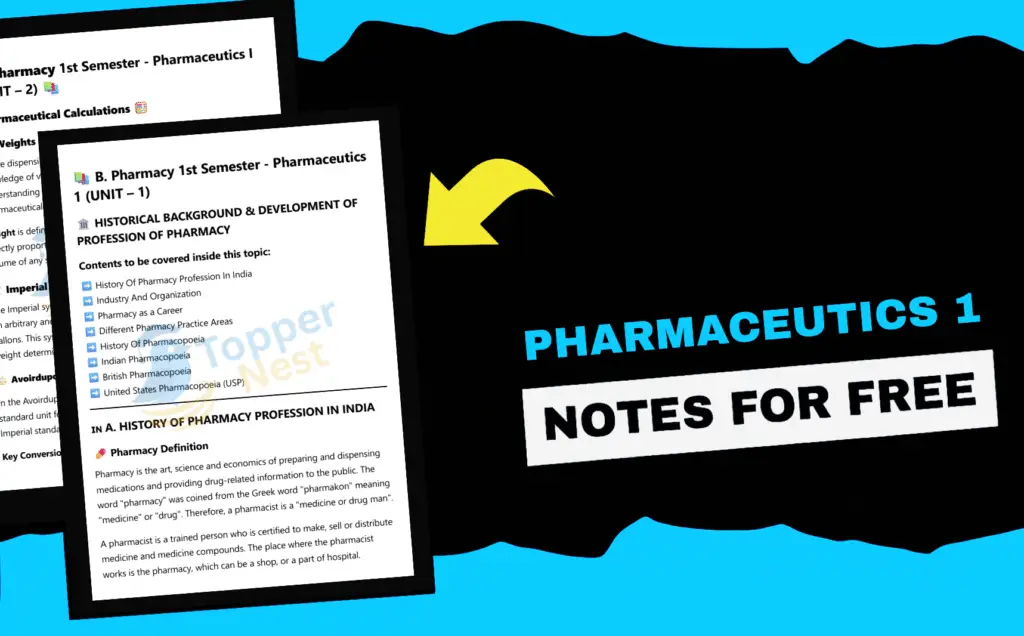If you’re a B. Pharmacy student, mastering Pharmaceutics 1 is essential. This subject forms the foundation of pharmaceutical education, focusing on the basic concepts, formulations, and processes involved in drug preparation and dosage form design.
In this article, you’ll find:
- Pharmaceutics 1 Notes PDF
- Unit-wise Breakdown
- Key Definitions and Concepts

What is Pharmaceutics 1?
Pharmaceutics I is a foundational course typically offered in the first year of a Bachelor of Pharmacy (B.Pharm) program. It introduces students to the core principles of pharmaceutics, which is the science of designing, preparing, and dispensing drug dosage forms. The course is a blend of theory and practical training, covering a wide range of topics essential for a pharmacist’s role.
Core Topics Covered in Pharmaceutics I
The curriculum for Pharmaceutics I is designed to provide a comprehensive introduction to the fundamental concepts of drug preparation and delivery. Key areas of study include:
- Introduction to Pharmacy and Pharmacopoeias: Students learn about the history of the pharmacy profession, its development, and its role in healthcare. They’re also introduced to official drug compendia, such as the Indian Pharmacopoeia (IP), British Pharmacopoeia (BP), and United States Pharmacopeia (USP), which set standards for drug quality and purity.
- Dosage Forms: This section covers the different forms in which drugs are administered, such as tablets, capsules, liquids, and topical preparations. Students learn about the advantages, disadvantages, and specific uses of each type.
- Prescriptions and Posology: Students learn to read and interpret prescriptions, identify common errors, and understand the legal and professional aspects of prescription handling. Posology—the study of drug dosage—is a key component, with a focus on calculating appropriate doses for different patient populations, including children, based on age, body weight, or body surface area.
- Pharmaceutical Calculations: This is a vital part of the course. Students learn to perform calculations for weights and measures, percentage solutions, dilutions, and isotonic solutions to ensure accurate drug compounding and dispensing.
- Preparation of Dosage Forms: A significant portion of the course is dedicated to the preparation of various dosage forms in a laboratory setting. This includes:
- Liquid Dosage Forms: Making syrups, elixirs, suspensions, and emulsions.
- Solid Dosage Forms: Preparing powders, granules, and suppositories.
- Semisolid Dosage Forms: Creating ointments, creams, and gels.
- Pharmaceutical Incompatibilities: Students are taught to identify and prevent undesirable interactions between different ingredients in a formulation, which can be physical (e.g., precipitation), chemical (e.g., degradation), or therapeutic (e.g., antagonistic drug effects).
Unit-wise Notes for Pharmaceutics 1
Why Pharmaceutics 1 is Important in B. Pharmacy
Pharmaceutics I is a fundamental subject in the B. Pharmacy curriculum because it serves as the gateway to all aspects of drug formulation and delivery. It provides the core theoretical knowledge and practical skills that a pharmacist needs to understand how a raw drug substance is transformed into a safe, effective, and stable medication.
Foundational Concepts
Pharmaceutics I introduces students to the basic principles that govern the pharmaceutical profession. It covers essential topics like the history of pharmacy, the role of official compendia (pharmacopoeias) in setting drug standards, and the proper way to handle prescriptions. These concepts form the ethical and legal groundwork for a pharmacist’s professional life.
Practical Skills and Safety
The subject is highly practical. Through lab sessions, students get hands-on experience in preparing various dosage forms, including:
- Liquid forms like syrups and emulsions.
- Solid forms like powders and suppositories.
- Semisolids such as ointments and creams.
This practical training is critical for developing the skills needed for compounding and manufacturing. It also teaches students to identify and correct pharmaceutical incompatibilities that could compromise a drug’s safety or efficacy.
Benefits of Our Pharmaceutics 1 Notes
Looking for a reliable study resource to excel in Pharmaceutics 1 during your B. Pharmacy course? Our professionally curated notes at Toppernest.com are designed to help you understand formulation concepts, pharmaceutical principles and dosage form development with ease and confidence.
Pharmaceutics 1 – Frequently Asked Questions (FAQs)
1. What is Pharmaceutics 1 in B. Pharmacy?
Pharmaceutics 1 is the study of formulation and preparation of pharmaceutical dosage forms. It includes basics like prescription reading, pharmaceutical calculations, and dosage form science.
2. What are the main topics covered in Pharmaceutics 1?
Key topics include:
- Introduction to Pharmaceutics
- Prescription and Posology
- Pharmaceutical Calculations
- Liquid Dosage Forms
- Semisolid and Solid Dosage Forms
- Incompatibilities
3. Why is Pharmaceutics important in pharmacy?
It helps students understand how medicines are formulated, dispensed and used safely. It lays the foundation for advanced subjects like industrial pharmacy and pharmaceutics II.
4. What are the types of dosage forms?
There are three main types:
- Solid (e.g., tablets, capsules)
- Liquid (e.g., syrups, elixirs)
- Semisolid (e.g., ointments, creams)
